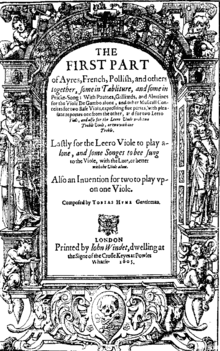Tobias Hume

Tobias Hume (* um 1569; † 16. April 1645 in London[1]) war ein schottischer Komponist, Gambist und Soldat.[2]
Über Tobias Humes Leben ist wenig bekannt. Als Geburtsjahr wird 1569 vermutet, da er 1629 in Londons Charterhouse aufgenommen wurde; Voraussetzung für die Aufnahme in dieses Armenhaus, war ein Alter von 60 Jahren. Seinen Lebensunterhalt hatte er möglicherweise als Söldner bestritten. Er diente als Hauptmann in der schwedischen und in der russischen Armee.
Humes veröffentlichte Musik umfasst Gambenstücke, darunter viele Solowerke für die Lyra viol, und Lieder. Seine Kompositionen erschienen in zwei Sammelwerken, The First Part of Ayres (auch Musicall Humors, 1605) und Captain Humes Poeticall Musicke (1607). Insbesondere trat er als Meister des Gambenspiels hervor (das Instrument war neben der Laute das beliebteste der Zeit). Er führte einen langjährigen Streit mit dem Komponisten und Lautenisten John Dowland, welches Instrument sich besser zum Zusammenspiel mit dem Gesang eigne.[3]
Als bekannter Witzbold verfasste er auf dessen Lesson for 2 to play on 1 Lute die Parodie An Invention for Two to Play upone one Viole für zwei Gambisten, bei der ein Spieler auf dem Schoß des anderen sitzt.[4] Sie streichen das Instrument mit zwei Bögen. In einem anderen Stück aus First Part of Ayres notierte Hume die Spielanweisung drum this with the backe of your bow („mit der Bogenrückseite trommeln“). Dies ist der erste Nachweis der Verwendung der Col-legno-Spielweise in der Musikgeschichte. Generell wird seine Musik durch einen improvisatorischen Tonfall bestimmt mit vielfältiger Rhythmik, freier Melodik und plötzlichen Änderungen in der Struktur.[5]
Weblinks
- Noten und Audiodateien von Tobias Hume im International Music Score Library Project
- Gemeinfreie Noten von Tobias Hume in der Choral Public Domain Library – ChoralWiki (englisch)
Einzelnachweise
- ↑ Konrad Ragossnig: Handbuch der Gitarre und Laute. Schott, Mainz 1978, ISBN 3-7957-2329-9, S. 41.
- ↑ McGuiness, David. Captain Tobias Hume: A Scottish Soldier (liner notes). Concerto Caledonia. "it was only in 1991 that the court accounts of James VI's consort Anne of Denmark were found to establish his nationality, in a 1606 payment to 'Tobias Hume a Scottish Musician in reward from her Majestie'."
- ↑ johndowland.de (Memento des vom 5. April 2009 im Internet Archive) Info: Der Archivlink wurde automatisch eingesetzt und noch nicht geprüft. Bitte prüfe Original- und Archivlink gemäß Anleitung und entferne dann diesen Hinweis., abgerufen am 21. September 2007
- ↑ Annette Otterstedt: Die Gambe. Kassel u. a.: Bärenreiter 1994. S. 37
- ↑ Astrid Kretschmar: Tobias Hume. In: Ingeborg Allihn (Hrsg.): Barockmusikführer. Instrumentalmusik 1550–1770. Metzler; Bärenreiter 2001, S. 236–238, hier 238.
| Personendaten | |
|---|---|
| NAME | Hume, Tobias |
| KURZBESCHREIBUNG | englischer Komponist, Gambist und Soldat |
| GEBURTSDATUM | um 1569 |
| STERBEDATUM | 16. April 1645 |
| STERBEORT | London |
Auf dieser Seite verwendete Medien
Autor/Urheber: Phillip W. Serna, Lizenz: CC BY-SA 3.0
Performed May 13, 2008, by Dr. Phillip W. Serna. Based in the Chicago area, Dr. Serna works to bring the early western string instrument family known as the viola da gamba into many area schools – demonstrating solo literature from the Renaissance, Baroque and early Classical periods for treble viol, tenor viol, bass viol & violone. For more information, visit http://www.thegambacast.org/ & http://www.violsinourschools.org/.
Title page of English composer Tobias Hume's First Part of Ayres, printed by John Windet in 1605. The work contains what may be the earliest examples of pizzicato and col legno.
Autor/Urheber: Dr. Phillip W. Serna, Lizenz: CC BY 3.0
No. 3 The First Part of Ayres - The Musicall Humours 1605
Performed by Dr. Phillip W. Serna. Based in the Chicago area, Dr. Serna works to bring the early western string instrument family known as the viola da gamba into many area schools – demonstrating solo literature from the Renaissance, Baroque and early Classical periods for treble viol, tenor viol, bass viol & violone.
For more information, visit http://www.thegambacast.org/ & http://www.violsinourschools.org/.Autor/Urheber: Phillip W. Serna, Lizenz: CC BY-SA 3.0
Captaine Tobias Hume (1569–1645) – "The Spirit of Gambo (The Lord Dewys Favoret)" from Captaine Hume's Poeticall Musicke (1607) is performed by Phillip W. Serna and Christopher Burrus from a recital at Valparaiso University and appears here by permission of the performers. Based in the Chicago area, Dr. Serna works to bring the early western string instrument family known as the viola da gamba into many area schools – demonstrating solo literature from the Renaissance, Baroque and early Classical periods for treble viol, tenor viol, bass viol & violone. For more information, visit http://www.thegambacast.org/ & http://www.violsinourschools.org/.
